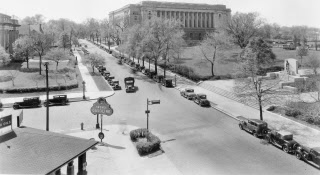We can't stay out of Springfield
After three days in Springfield, Illinois, for the International Mother Road Route 66 Festival, we intrepid researchers - Joe Sonderman and I - headed back north again the very next day to the Lincoln Library on Seventh Street to immerse ourselves (again) in the wonderful Sangamon Valley Collection.
Our first research trip for "Route 66 in Illinois" was on a bone-chilling, snowy day back in January. Since then, Joe and I have traveled up and down Route 66 throughout Illinois to ferret out amazing and intriguing vintage photos. We have made numerous trips to and through Springfield. The capitol is a great historic city in which I've had the privilege of living twice. Sometimes, memories from my childhood there combine with a historic image and I really want to just walk into one of those photo scenes...for just a little while, anyway.
I'm particularly intrigued with the Springfield of the 1920s and early 1930s, the Springfield that Route 66 first traversed when it was a young highway following old Route 4. For part of its path through the city, Route 66 came right down Second Street, past the capitol itself and its associated state buildings. Sweney's Service Station anchored the northeast corner of Second and Capitol, where the Illinois State Library Gwendolyn Brooks Building now stands. The grand old hotels - the Abraham Lincoln, the Leland, and the St. Nicholas - stood sentinel over the downtown. Two of those, the Leland and the St. Nicholas, survived Springfield's 'progress'; the Abraham Lincoln did not. A half-dozen theaters, the grandest of them considered to be the Orpheum, were playing films by Buster Keaton, Charles Chaplin, and Alfred Hitchcock.
All of the above photos are courtesy of the outstanding Sangamon Valley Collection.
Springfield still pulls me back. It's a good thing we're working on this book so I've got an excuse to be there so often. We just can't stay out of Springfield.
Our first research trip for "Route 66 in Illinois" was on a bone-chilling, snowy day back in January. Since then, Joe and I have traveled up and down Route 66 throughout Illinois to ferret out amazing and intriguing vintage photos. We have made numerous trips to and through Springfield. The capitol is a great historic city in which I've had the privilege of living twice. Sometimes, memories from my childhood there combine with a historic image and I really want to just walk into one of those photo scenes...for just a little while, anyway.
I'm particularly intrigued with the Springfield of the 1920s and early 1930s, the Springfield that Route 66 first traversed when it was a young highway following old Route 4. For part of its path through the city, Route 66 came right down Second Street, past the capitol itself and its associated state buildings. Sweney's Service Station anchored the northeast corner of Second and Capitol, where the Illinois State Library Gwendolyn Brooks Building now stands. The grand old hotels - the Abraham Lincoln, the Leland, and the St. Nicholas - stood sentinel over the downtown. Two of those, the Leland and the St. Nicholas, survived Springfield's 'progress'; the Abraham Lincoln did not. A half-dozen theaters, the grandest of them considered to be the Orpheum, were playing films by Buster Keaton, Charles Chaplin, and Alfred Hitchcock.
 | |||||||||
| The view heading south on Second Street/Route 66 in 1929. |
 | |
| Sweney's Service at the intersection of Second and Capitol (same station as in first photo). |
 |
| The Leland Hotel, said to be the spot where the Horseshoe sandwich was invented. |
 |
| The Orpheum Theater in a later decade. A matinee here with my mom when I was a little girl was special. |
Springfield still pulls me back. It's a good thing we're working on this book so I've got an excuse to be there so often. We just can't stay out of Springfield.



Comments
Post a Comment